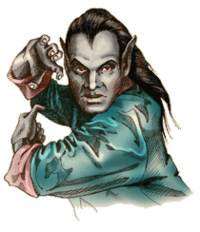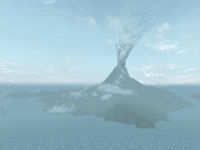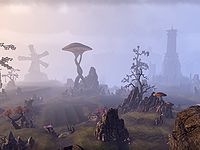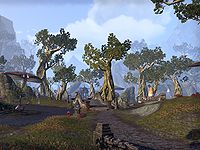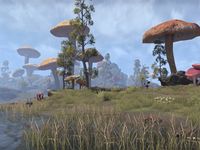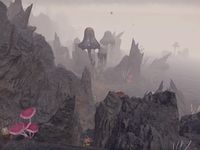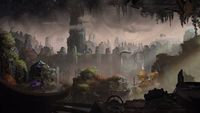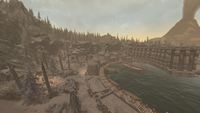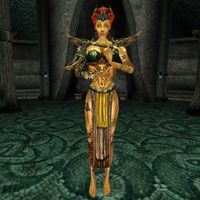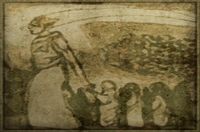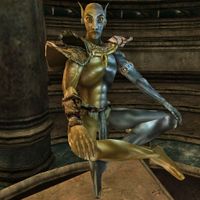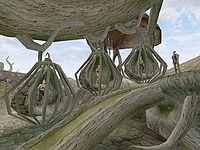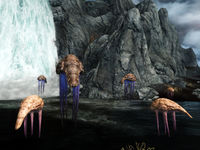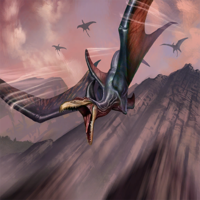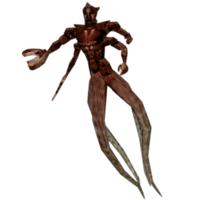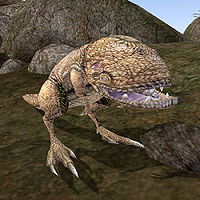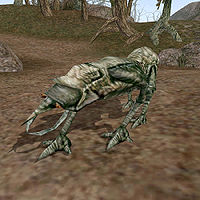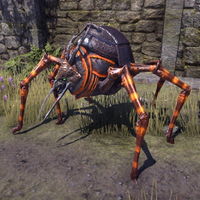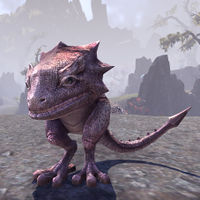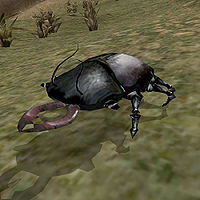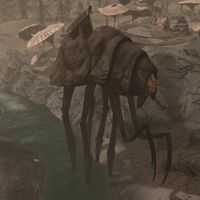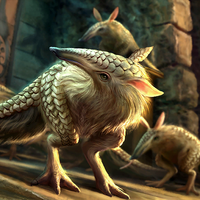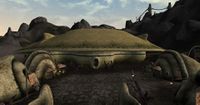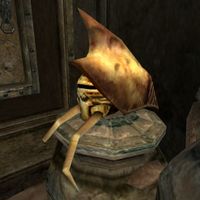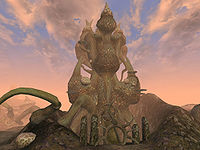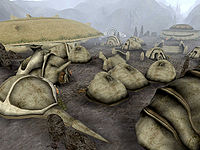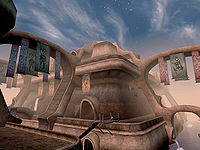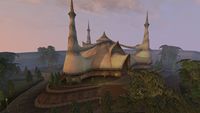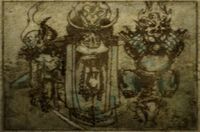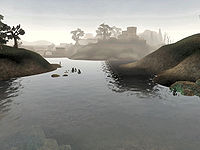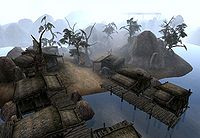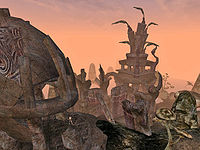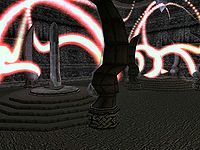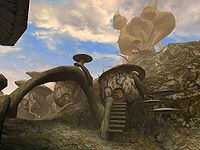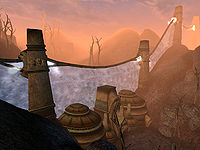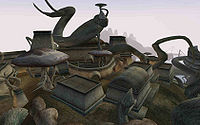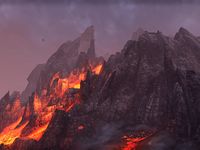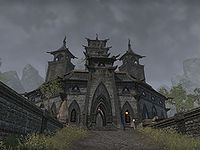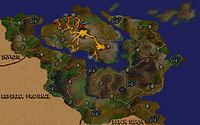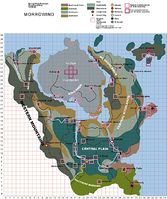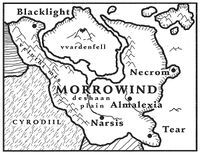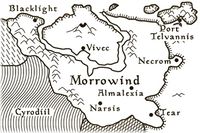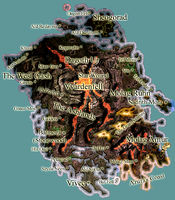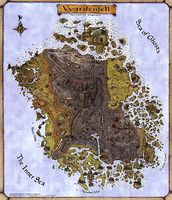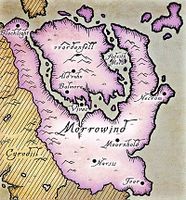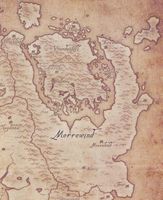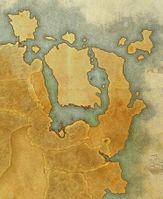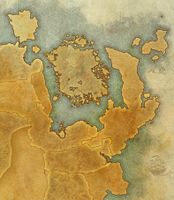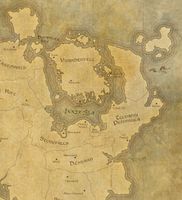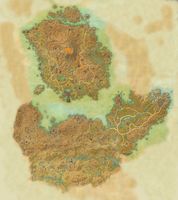Lore:Morrowind
| Morrowind | |
|---|---|
| Type | Province |
| Continent | Tamriel |
| Demonym(s) | Resdaynian, Resdayni |
| Appears in | Arena, Morrowind, Dragonborn, ESO, Legends |
Morrowind, previously named Dwemereth, Veloth, Resdayn, Resdaynia, and Dunmereth,[1] and also known as the Land of Ash,[2] is the nation in the northeast corner of Tamriel, and the home of the Dunmer. It is dominated by the large island of Vvardenfell and its centerpiece, the ash-spewing Red Mountain, but also includes territory on the continental mainland. The Inner Sea separates Vvardenfell from the mainland, and the Sea of Ghosts lies to the region's north and east.[3][1][4] Solstheim, an island in this sea near northwestern Morrowind, has not traditionally been associated with any particular province, though Morrowind had long maintained a theoretical claim to it.[5] The Nords of Skyrim conceded the island to Morrowind in 4E 16 following the Red Year, allowing the Dunmer to settle it without contest.[6][7]
Geography[edit]
Morrowind is the northeasternmost nation of Tamriel, bounded on the north and east by the Sea of Ghosts, on the northwest by Skyrim, on the southwest by Cyrodiil, and on the south by Black Marsh.[8][9][10] There are numerous crossings on Morrowind's borders with the other provinces, such as Chinzinch Pass,[11] Shadowgate Pass,[4] Kavas Rim Pass along Cyrodiil's border,[12] as well as Dunmeth Pass and potentially Frimvorn Pass near Skyrim's border.[13][14]
Morrowind is the seat of intense volcanic activity that shapes its landscapes. The Velothi Mountains separate Morrowind from Skyrim, and the Valus Mountains separate it from Cyrodiil; all of these ranges and borders intersect at the peak of Trolhetta.[15] As a result of this isolation, Morrowind has developed a unique ecosystem. The area south of the Inner Sea is composed of the tormented volcanic coasts of Stonefalls and Bal Foyen. They lead further south to the fertile Deshaan plain and the marshes that surrounds Tear. Most of the modern population of Morrowind is gathered in the high hilly uplands and rich fertile river valleys of central Morrowind, especially around the Inner Sea.[8]
Cloud movement shows that the province is predominantly exposed to upper-level southerly winds, resulting in a mild, though often hot, climate. Morrowind is mostly free from snow and ice (excluding Solstheim), unlike other parts of Tamriel at the same latitude.
Morrowind is composed of several districts:
- The Vvardenfell District on the eponymous great island, dominated by the huge Red Mountain and separated from the continent to the west, south and east by the Inner Sea. It was formerly the domain of House Dagoth and the Dwemer.
- The Dres District in the south and southeast, amid the plains near the border with Black Marsh.
- The Indoril District in the central heartlands and eastern coast, amid the fertile river valleys.
- The Telvanni District in the extreme northeast, made up of their remaining island settlements.
- The Redoran District in northwest, found in the lands along the Velothi Mountains with Skyrim's borders and the Inner Sea.
- The Sadras District of unknown coverage though presumably in the central/southwest mainland as their predecessors, the Hlaalu, resided in.
The Clockwork City created by Sotha Sil, one of the three living gods of Morrowind, exists outside of the reality of Nirn.
Depending on the Era, the island of Solstheim to the northeast is part of either Morrowind or Skyrim.
Vvardenfell[edit]
- This article is about the island. For the island's central volcano, also known as Vvardenfell, see Red Mountain.
Vvardenfell, also called the Black Isle, is a large island located inside the bay-like Inner Sea, and is surrounded by mainland Morrowind with the exception of its northern coast, which meets the Sea of Ghosts. The island is dominated by the great volcano, Red Mountain. The island itself is named after the original Dwemeri name of Red Mountain, literally translating to "City of the Strong Shield". It is characterized by arid wastes, rocky highlands and coastal wetlands filled with unusual and unique flora and fauna.
In ancient times, the majority of Morrowind (then named Resdayn)'s population was concentrated in Vvardenfell. After the Sun's Death eruption in 1E 668 made the island largely inhospitable, there was a permanent population shift to the mainlaind.[1] Most of the remaining population of Vvardenfell was confined to the relatively hospitable west and southwest coasts.[10]
Before the eruption of Red Mountain in 4E 5, the landscape of Vvardenfell was diverse, with the grasslands of the Ascadian Isles and Grazelands, the dry plains of the West Gash, the volcanic crags of the Ashlands, Molag Amur and Red Mountain, and the coastal areas of Azura's Coast, the Bitter Coast, Zafirbel Bay and the Sheogorad region.[3]
Stonefalls[edit]
Stonefalls is a region situated in the western mainland along the southwestern shore of the Inner Sea.[16] It borders Bal Foyen to the east, Deshaan to the south, Cyrodiil to the west, The Rift in Skyrim to the northwest, and the Morrowind part of the Velothi Mountains to the north. The region contains the cities of Davon's Watch, Ebonheart, and Kragenmoor. Other notable places include the necropolis of Othrenis and two great volcanoes, Ash Mountain and Tormented Spire.[17]
The region's landscape fluctuates from volcanic crags to fertile fields and fungal forests.[17]
Bal Foyen[edit]
Bal Foyen is a tiny, swampy region on the southeastern shore of the Inner Sea, situated between Stonefalls and Fungal Lowlands. The region contains the town of Dhalmora and Fort Zeren.[17]
Deshaan[edit]
Deshaan is the broad southern plain which gradually slopes down into the dismal swamps of Black Marsh. Deshaan is a southern region of Morrowind, situated between Stonefalls, Cyrodiil, Shadowfen in Black Marsh, and the northeastern and southeastern coastal areas of Morrowind. The region contains the city of Mournhold, surrounded by Lake Amaya, as well as Narsis on the shores of Lake Hlaalu. It is also home to the magical academy of Shad Astula and the Shrine of Saint Veloth.[17]
The region consists of lush green areas, fungal forests, and southeastern swamps.[17]
Southern Morrowind[edit]
House Dres rules the southern sweep of Morrowind, where the fertile Deshaan plain merges with the swamps of Black Marsh.[10][18] The southeast is a warm coastal plain with broad cultivated areas and marshes and swamps similar to those found in Black Marsh. Southeast Morrowind is flat, wet, and warm.[10][18] The area around Tear is much hotter than the Grazelands and is "practically Argonia".[19]
Northwest Morrowind[edit]
The west region is found east of the Velothi Mountains bordering Skyrim and has settlements such as Cormaris View and Silgrad Tower, as well as a region called the Great Valley. The city of Blacklight, a Redoran stronghold, is located at its northern extremity, near the Dunmeth Pass. The Mountain Orcs are found here as well.
House Redoran guards the western flank of Morrowind.[4] The Nords of Skyrim are still resentful of the land lost in 1E 416, and enviously covet the House Redoran-ruled coast and highlands of Morrowind's northwest borders, at times assaulting them.[20][21] The Nords have never been comfortable with the fact that the Dark Elves hold the west coast of the Inner Sea all the way up to Blacklight; and in some cases their maps elide that fact entirely.[UOL 1][10][18]
Fungal Lowlands[edit]
The Fungal Lowlands are a spacious tract of wilderness and river valleys along the southeast corner of the Inner Sea. It is composed of flatlands along the river, with a number of secluded clearings between the road and the coast.
It's main settlement was Ald Isra where the Assembly of Masters occasionally met.
Padomaic Crest[edit]
The Padomaic Crest is a volcanic range found along the Padomaic Ocean. The eastern end of the formation creates a secondary peninsula where the city of Necrom lies.
The east coast of Morrowind is a treacherous cliff coastline, especially in the region around Necrom.[22]
The island of Gorne is found north of Necrom, in the bay between the Padomaic Crest and the Great Arm.[23]
Northeast Morrowind[edit]
The northeast region of Morrowind includes all the land north of Necrom. The region is characterized with rocky coasts and islands, as well as a number of settlements.[18] Its main city is Firewatch at its northern end.
The northern lands are very dry compared to the temperate southern lands,[24] and the landscape consists of fertile plains in the east and badlands in the west,[UOL 2] the north in particular having arid desert plateaus, mesas, and high steppes.[UOL 3] Inhabitants of the mainland wear "Dust Adept" clothing to adapt to this dry environment.[25][26]
The island of Vounoura are found near the area. The Telvanni capital city of Port Telvannis is found in an archipelago of the Sea of Ghosts in the extreme northeast.[27][UOL 2][2] The archipelago of the northeast has a mix of flat and rocky rugged terrain with a few settlements.[28][29]
Clockwork City[edit]
The Clockwork City, also known as Sotha Sil,[30] is a metaphysical clockwork realm created by Sotha Sil, one of the living gods of Morrowind, to replicate the mythic structures of Nirn in metallic miniature.[31] It supposedly exists "outside space and time",[UOL 4] and in the physical world, it is represented in the form of a Clockwork Globe that is no larger than a good-sized netch, and requires an individual to be magically shrunk to enter.[32][33][32]
Many tales are told of Sotha Sil's Clockwork City of brass, with some sources claiming it was hidden in the steaming swamps of southern Morrowind, serving as the lair of the most mysterious member of the Tribunal.[4]
The Clockwork City of Sotha Sil was secretly located deep beneath Mournhold in 2E 582;[33] contradicting rumors placed it in Morrowind's hot southern swamps,[4] and beneath Ebonheart,[34] though given the city's diminutive size, it is possible it was moved to various locations over time to ensure its safety.
Solstheim[edit]
Solstheim is a large island in the Sea of Ghosts to the north of Tamriel. The Snow Elves were the first inhabitants of the region, and built many grand settlements that far outlasted their mainland holdings. It officially became a region of Morrowind in 4E 16. The island has a long history of habitation by other races, but it has traditionally been primarily Nordic in influence.
History[edit]
"Dwemereth" had been inhabited by the Dwemer since time immemorial, but the history of Morrowind under their rule is a mystery. When the exiled Chimer led by the prophet Veloth left Summerset Isles and came to what they considered their promised land,[35] they found the Dwemer were already well-established in their underground colonies. The two races would not live in peace, as disputes over land and religion regularly led to conflict.[1] They would, however, unite against a common enemy following almost two hundred years of oppression by the Nords of Skyrim, who invaded the area circa 1E 240.[13] Due to the personal friendship between Indoril Nerevar of the Chimer and the Dwarf-King Dumac of the Dwemer, an alliance was formed between them, and the Nords were pushed out by 1E 416. This alliance born out of need formed the First Council.[4]
Resdayn[edit]
Nerevar and Dumac ruled jointly over "Resdayn". The peace between the Dwemer and Chimer brought prosperity, but the War of the First Council broke out when relations went sour. It ended with the Battle of Red Mountain, which saw the death of both leaders. Almalexia, Sotha Sil, Vivec, and Dagoth Ur tapped the Heart of Lorkhan to attain god-like powers (though Dagoth Ur would disappear until 2E 882).[36][37] As a result, the Chimer changed into the Dunmer.[36] Red Mountain erupted (during the battle, apparently),[38][39] laying waste to half of Morrowind and beyond.[4] 1E 668 is known as "Sun's Death" and the "Year of Winter in Summer".[13] It's believed that this eruption created the Inner Sea and destroyed entire cities,[40][22][41][42] and led to a population shift to the south. It was sometime after this eruption that the land became known as Morrowind.[4][1] Some sources seem to suggest this name wasn't popularized until the late Second Era.[35]
Tribunal Morrowind[edit]
Morrowind under the Tribunal marks the beginning of Dunmeri history. The Tribunal consolidated their power and succeeded in incorporating themselves into the Chimeri belief system of ancestor and Daedra worship, at the expense of the worship of the House of Troubles, whom the Dunmer know as the "Bad Daedra".[43] Massive shrines to those four Daedric Princes still dot Morrowind, though at the close of the Third Era, they were abandoned ruins typically inhabited by monsters and criminals.[3] The Tribunal replaced the First Council with the Grand Council of Morrowind,[44][45] and performed many amazing deeds as the Dunmer's immortal protectors and leaders. Cyrodiil sought to incorporate Morrowind into the Empire of the Reman Dynasty, perpetrating the bloody Four-Score War, which ultimately ended in a treaty.[1] In 2E 373, the Dragonguard reported the Dragon Ahbiilok to be lairing somewhere in Morrowind.[46]
In 2E 572, the Akaviri army of Ada'Soom Dir-Kamal invaded northern Tamriel. They were defeated at Stonefalls by the combined forces of the Nords (along with Wulfharth Ash-King), Dunmer legions of Almalexia and Argonian Shellbacks.[16][47] This event led to the formation of the Ebonheart Pact, an uneasy alliance between the Nords, the Dunmer and the Argonians. The Pact later participated in the Alliance War.[48]
Much to the surprise of almost everyone, no such conflict occurred at the rise of the Third Empire, and Tiber Septim's ambitions of conquest were fulfilled through diplomacy. Vivec and Tiber Septim reached an agreement in the Armistice around 2E 896. The Dunmer became Imperial citizens and submitted to Imperial occupation and the incursion of Cyrodilic institutions and business interests, but retained self-rule, house traditions, and religious practices. Vivec secretly supplied the Emperor's agents with the golem Numidium as part of this deal.[1][44][49]
The Dunmer, and the Chimer before them, divided Morrowind into political districts based on their Great Houses. An unknown number of Great Houses rose and fell over the years, but in the late Third Era, House Redoran controlled the western mainland bordering Cyrodiil and Skyrim. House Hlaalu controlled the central western part of the mainland. House Indoril controlled the central eastern part of the mainland. House Dres controlled the area forming the border with Black Marsh. House Telvanni controlled the eastern region of the nation.[3][4][50] For ages, Vvardenfell was a Temple preserve predominantly inhabited by a few Great House settlements and Ashlanders, but it was opened to greater settlement in 3E 414.[35] House Telvanni snatched up the east, House Hlaalu took some of the center and the marshy southwest, and House Redoran held dominion over the remaining areas, though it largely refused to expand settlement.[35][50]
In the early-mid Third Era, Prince Uriel Mantiarco of Solitude garnered support from many disgruntled kings of Morrowind,[51] including Ebonheart[52] and other northern provinces, and coordinated three attacks across the Empire. The second attack was in eastern Morrowind and targeted Imperial garrisons across the coastal islands. Kintyra II's consort, Kontin Arynx died while defending these forts. While the Imperial Army was split between eastern Morrowind and western High Rock, Prince Uriel used that time to invade the Imperial City and proclaim himself Emperor Uriel Septim III.[51]
The War of the Red Diamond henceforth was underway. Emperor Uriel III and his mother, Potema had support across all of Skyrim and northern Morrowind, while High Rock was contentious when the Emperor's uncle, King Cephorus of Gilane re-conquered western High Rock.[53][54] King Magnus of Lilmoth led his Argonian army in the battle for Morrowind. In the summer months, Magnus' warriors fought well but had to retreat during the winter. The second century Sage, Inzolicus believed that this setback made the war last two more years than needed.[54] Meanwhile, the Empire's historical ally, Mournhold led by King Symmachus won many battles.[52]
The war ended when Uriel III was defeated by Cephorus and killed in a riot in 3E 127, and when Potema died during the Siege of Solitude in 3E 137. When Cephorus became Emperor of Tamriel as Cephorus Septim I, the kings across Tamriel offered their complete support in exchange for new levels of autonomy and independence.[55] When the Emperor passed away only three years after the siege on Solitude, his brother Magnus replaced him and spent the rest of his reign mending political damage from the war, either by forming new relations or punishing traitorous kings.[53] To form a clean slate with Ebonheart, Emperor Magnus I arranged the marriage of his son, King Pelagius of Solitude and the heiress of the Ra'athim clan, Katariah.[52]
Morrowind under the Tribunal was distinct from most of Tamriel in many ways. For one, their legalization of assassination set them apart.[4] Also, the Dunmer banned Necromancy in their land long before the Mages Guild saw fit to do so.[56][57] However, necromancers could continue to operate secretly thanks to another peculiar Morrowind institution: slavery.[56] For ages, the Dunmer had enslaved humans and elves, but mainly concentrated on Beastfolk, namely Khajiit, Argonians, and Goblins. The right to retain this tradition was guaranteed by the Armistice, and it continued for virtually all of the Third Era, mainly due to the lobbying of Houses Dres and Telvanni, and despite the general abhorrence of the institution by the rest of Tamriel.[3][4][58] In the final years of the era, the new King Helseth, looking for a way to exert his authority, banned the controversial practice, eliciting an initially bloody reaction.[1] As the Dunmer would find out, though, their transgressions were not forgotten.
Dagoth Ur awoke beneath Red Mountain in 2E 882, heralding enormous changes in Morrowind. The Tribunal led campaigns against him and his monsters for over four hundred years.[37] Around 3E 417, the Great Ghostfence was erected to contain the threat,[59] though some sources suggest the Ghostfence existed for centuries before this.[35][60] The enormous shimmering-blue barrier encircled the entire Red Mountain region of Vvardenfell, but still, Dagoth Ur's monsters and The Blight managed to seep through. With the advent of the Nerevarine in 3E 427, Almalexia, Sotha Sil, and Dagoth Ur were soon dead, and Vivec went missing. The Dunmer were still struggling to come to terms with this at the close of the Third Era.[3][61]
The Fourth Era[edit]
After the Oblivion Crisis, the Nords and Orcs launched attacks.[62] In Vivec's absence, the Ministry of Truth eventually fell, destroying Vivec City and causing Red Mountain to erupt, covering the rest of Vvardenfell in ash and lava. Since this Red Year of 4E 5, Red Mountain has been spewing ash even more regularly than before, and Vvardenfell remains largely uninhabitable. When Solstheim came under Dunmer rule, the Redoran took over its administration, though the Telvanni also established the settlement of Tel Mithryn.[63]
The Argonians of Black Marsh, meanwhile, were stronger than ever and soon invaded Morrowind, seizing large tracts of land that had long ago belonged to them.[62] They also sacked many cities, including Mournhold, in southern Morrowind. Though a Redoran army halted their advance, countless Dunmer were killed or displaced,[64] and they were forced to establish dozens of colonies elsewhere, including the island of Solstheim.[65] Apart from organized colonies, many Dunmer refugees have settled in Skyrim, especially in the so-called Gray Quarter of Windhelm. Though Mournhold was rebuilt,[66] the capital of Morrowind was moved to the Rootspire in the Redoran city of Blacklight, as the leadership House Redoran had exhibited had greatly increased their power and influence.[67]
The Empire's ineffectual protection and seeming indifference to Morrowind's plights made them reviled by the Dunmer. After the Empire "released its grasp" on Morrowind,[64] House Hlaalu's Imperial ties resulted in it being replaced by House Sadras on the Council of Great Houses.[68][69]
Flora[edit]
Tibrol is a species of tree that grows in Morrowind, known for its longevity and for serving as nesting spots for birds.[70] The largest plantlife in Morrowind is the mighty emperor parasol mushroom, a fungus the size of a tree. They dot the landscape of Morrowind, particularly in Telvanni regions. Other types of fungi include Bloatspore, bungler's bane, hypha facia, luminous russula, and violet coprinus. Much of the flora of Morrowind must be adapted to its harsh environment, like the black lichen, fire fern, and Chokeweed, which are found in many rocky, infertile areas. Kreshweed and Saltrice appear to thrive in salt water, and can be found along Morrowind's extensive coastline. Some plants haven't adapted and thus are rare, like red and green lichen.[3][61] Other tree species found in the province include ash laurels, cedars, and poplars.[71]
The Dunmer have managed to make do with what they've been given. They have domesticated many plants, such as scrib cabbage plants, which are commonly grown within indoor planters. Wickwheat is an edible grain that grows in the wild. Saltrice is both an important food crop and the main ingredient in the popular alcoholic beverage mazte. Muck is prepared from the common muckspunge plant. The roots of Trama shrubs are used to make tea. The berries of the comberry plant are edible, though they are known for their bitterness. Something tastier, like the hackle-lo leaf or Marshmerrow pulp, are more preferred. Corkbulb is grown because its tough roots are used for construction in lieu of large amounts of wood. Dunmer have long made ash yams a staple of their diet, as the hardy vegetable can thrive when planted in ash (hence its name).
Some of their vegetation is sought for the alchemical ingredients they offer, such as draggle tail, the moss of an emperor parasol, meadow rye, Nirthfly, Roobrush, Scathecraw, slough ferns, spike grass, spiny lloramor, and Sweetbarrel. Flowering Bittergreen vines can be found in wet and dry regions alike. Various other flowers include the black anther, gold kanet, golden sedge, Heather, horn lily, noble sedge, Stoneflower, timsa-come-by, and the willow flower.[3][61]
Fauna[edit]
Much of the Fauna of Morrowind is uniquely adapted to and dependent on the ashfall from Red Mountain.[2] Due to their domestication, Silt Striders, Netches, and Guar are some of the most iconic beasts of Morrowind. But not to be forgotten are the Kwama, enormous cave-dwelling insects in Vvardenfell whose eggs the Dunmer have made an industry of "mining" for food. The Sand Kwoom and long-legged Velks are species not often seen outside of the province due to their reliance on kresh-weed.[2] Slaughterfish and Dreugh fill the waters of Morrowind, and Mudcrabs line the shores. Bothersome cliff racers dominate the sky in numbers so great they are said to have driven off the Dragons (though the racers themselves were purportedly driven from Vvardenfell by Saint Jiub). Some claim instead that the strange floating gas bags known as Skylamps ate the Dragons.[2]
The large, black Shalk bugs in the wilderness can attack with magical fire if threatened. Various Daedra, such as the Winged Twilight, roam the landscape along with various ash creatures and more natural beasts like the Alit, Kagouti, and packs of Nix-Hounds. Goblins have been known to inhabit the depths of Morrowind, where they kept Durzogs, ferocious dog-like reptiles, as patrols and war animals. And, like virtually every other place in Tamriel, Rats are common.[3][61]
The island of Vvardenfell used to hold more unique animals such as the Cliff Strider, the Nix-Ox, and Vvardvark, but by the late Third Era, Ash Blight had wiped them out on the island, though all three species were also known to live on mainland Morrowind. Verminous were bipedal therapods once common across Velothi lands that went extinct long ago.[72] Another exotic thing even among the alien wildlife in Morrowind is the bizarre, bioluminescent, and possibly sentient Land-Coral species that grows on the land around the Inner Sea of Mainland Morrowind and Vvardenfell.
Architecture[edit]
Several architectural styles can be seen in Morrowind:
- Dunmeri styles:
- Redoran style, with organic buildings shaped like (and sometimes made from) crustaceans and mollusks. This style was present in Vvardenfell in the Second[33] and Third Eras.[3] The most impressive Redoran structure was Under-Skar, the mostly subterranean but palatial manor district of Ald'ruhn, built inside, below, and around the giant shell of an Emperor Crab.
- Hlaalu style, with simple, stuccoed stone, and a multi-level design often involving stairways and ramps. The style – squarish with rounded edges, and often buttressed – was present in Vvardenfell in the Second[33] and Third Eras.[3], reaching its pinnacle in the design of the city of Vivec.
- Telvanni style, with bizarre, twisted mushroom towers and dwellings, which are magically grown rather than built. This style was present in Vvardenfell in the Second[73][33] and Third Eras,[3] and also found in Fourth-Era eastern Solstheim.[63]
- Velothi style, which is seen in ancestral tombs, ancient towers, and Temple buildings.[3][17] Of the later styles, it most clearly influenced Hlaalu.
- Responsible Architecture, a style that is attributed to the Daedric Prince Boethiah.[40] This style was similar to that seen in various Daedric ruins in Morrowind, and it was used by the famed architect Guylaine Marilie to build a prison to contain Daedra at the site where Fort Arand was later constructed.[74]
- An unnamed style, featuring ornate stone buildings with peaked, shingled roofs, was common in mainland Morrowind in the Second Era and even extended into Cyrodiil. The city of Mournhold retained the style in the Third Era.[3][17]
- Other styles:
- The Imperial settlements founded in Vvardenfell after 3E 414 were built in the traditional Imperial style.[3]
- Daedric and Dwemer ruins dated to the early First Era are a common sight in Morrowind, both in Vvardenfell and on the mainland.[3][17] The heavy curved vaults of the Daedric shrines are considered comfortable by the Dunmer due to their sturdiness, but outsiders regard them as brutal and oppressive.[75]
- Argonian architecture in the form of bulbous, gourd-like mud structures flourished for a time in mainland Morrowind after the formation of the Ebonheart Pact and the freeing of Argonian slaves in the Second Era.[17]
Notable Places[edit]
Vvardenfell[edit]
- Ald'ruhn
- A Redoran city in western Vvardenfell, southwest of Red Mountain.
- Balmora
- A Hlaalu city in the southwest area of Vvardenfell, on the Odai River.
- Castle Ebonheart
- The seat of Imperial authority in Vvardenfell. Housed Vvardenfell's ruling Duke and Grand Council, as well the headquarters of the Imperial Cult and East Empire Company.
- Gnisis
- A fairly large town on the northwestern coast of Vvardenfell.
- Red Mountain
- The volcano in the center of Vvardenfell, and the former capital of the Dwemer.
- Sadrith Mora
- A Telvanni city on an island in the archipelago off the eastern coast of Vvardenfell.
- Seyda Neen
- A small Imperial city in southwest Vvardenfell.
- Vivec
- A major city off the southern coast of Vvardenfell and home of the god Vivec. Destroyed by the fall of the Ministry of Truth.
Mainland Morrowind[edit]
- Almalexia
- A major Indoril city in southern Morrowind, surrounding Mournhold.
- Blacklight
- A Redoran city in the Redoran district in northwest Morrowind. Became the capital after Almalexia was sacked.
- Clockwork City
- An underground complex created by Sotha Sil, a member of the Tribunal.
- Davon's Watch
- An Indoril city east of Ebonheart.
- Firewatch
- A city in the northern Telvanni district in northeastern Morrowind.
- Kragenmoor
- A city controlled by Dres and later Hlaalu in western Morrowind.
- Mournhold
- An Indoril city in the Deshaan Plain. The capital of Morrowind up until 4E 5.
- Narsis
- A Hlaalu city in southwestern Morrowind.
- Necrom
- The City of the Dead. A Temple city built around a great necropolis on the eastern coast of Morrowind.
- Ebonheart
- A Dres city located south of Vvardenfell, on the southern coast of the Inner Sea.
- Tear
- A Dres city on the southeastern coast of Morrowind.
Solstheim[edit]
- Raven Rock
- A Redoran city located on the southern coast of Solstheim, in the ashlands that were once the Hirstaang Forest.
Gallery[edit]
Maps[edit]
Notes[edit]
- Morrowind was featured in Arena, Morrowind, and ESO. Only Solstheim was featured in the Dragonborn add-on for Skyrim, though parts of Vvardenfell and mainland Morrowind were visible.
- Morrowind as a name was likely influenced by Morrowindl, a volcanic island home to elves in The Elf Queen of Shannara (from a series of fantasy books by Terry Brooks). Additionally, in Arena, the geography of the Black Isle (later named Vvardenfell) has similarities to the map of Morrowindl.[UOL 5][UOL 6] However, beyond surface level comparisons, the Morrowind of Elder Scrolls and the Morrowindl of Shannara share few similarities.
See Also[edit]
- For game-specific information, see the Arena article.
Books[edit]
- Ancestors and the Dunmer — An outdated guide for foreign visitors to Morrowind
- The Eastern Provinces — On the benefits and liabilities of the ongoing management of Morrowind and Black Marsh
- Great Houses of Morrowind — A description of the five great houses of Morrowind
- Guide to Ald'ruhn — An overview of Ald'ruhn's people and notable places
- Guide to Balmora — An overview of Balmora's people and notable places
- Guide to Sadrith Mora — An overview of Sadrith Mora's people and notable places
- Guide to Vivec — An overview of Vivec's people and notable places
- Guide to Vvardenfell — An overview of the district of Vvardenfell
- Kagouti Mating Habits by Edras Oril — Everything you never wanted to know about kagoutis' private lives
- A Less Rude Song by Anonymous — A standard bawdy ballad
- On Morrowind by Erramanwe of Sunhold — A historical synopsis of the Imperial conquest of Morrowind
- Pocket Guide to the Empire, 1st Edition: Morrowind by Imperial Geographical Society
- Pocket Guide to the Empire, 3rd Edition: The Temple: Morrowind by the Imperial Geographical Society
- The Reclamations by Thara of Rihad — An account of changes in the Dunmer religion following the end of the Tribunal
- The Red Year by Melis Ravel — Dunmeri accounts of the cataclysm in Morrowind
- Ruins of Kemel-Ze by Rolard Nordssen — An archaeologist's adventure through ancient Dwemer ruins
- Saint Jiub's Opus by Jiub — Saint Jiub the Eradicator of the Winged Menace recounts his rise to glory
- A Short History of Morrowind by Jeanette Sitte — Some excerpts from the book's introduction and its section on Vvardenfell
- Vampires of Vvardenfell — A book giving an overview of vampirism in Morrowind
- Zainsubani's Notes by Hassour Zainsubani — Notes on the Ashlanders and the Nerevarine Cult
References[edit]
- ^ a b c d e f g h Pocket Guide to the Empire, 3rd Edition: The Temple: Morrowind — Imperial Geographical Society, 3E 432
- ^ a b c d e People of Morrowind — Various
- ^ a b c d e f g h i j k l m n o p Events of Morrowind
- ^ a b c d e f g h i j k Pocket Guide to the Empire, 1st Edition: Morrowind — Imperial Geographical Society, 2E 864
- ^ Lord of Souls — Greg Keyes
- ^ Decree of Monument
- ^ History of Raven Rock — Lyrin Telleno
- ^ a b Provinces of Tamriel
- ^ Guide to Vvardenfell
- ^ a b c d e Morrowind Generic Dialogue topics: Geography of Morrowind, Morrowind, Vvardenfell
- ^ Chronicles of Nchuleft — An Anonymous Altmer
- ^ 2920, Second Seed — Carlovac Townway
- ^ a b c Pocket Guide to the Empire, 1st Edition: Skyrim — Imperial Geographical Society, 2E 864
- ^ Ancient Tales of the Dwemer — Marobar Sul
- ^ Trolhetta in ESO
- ^ a b The Second Akaviri Invasion — Yngmaer Raven-Quill, Historian Royal of the Bards' College, Solitude
- ^ a b c d e f g h i Events of ESO
- ^ a b c d Elone's dialogue in Morrowind
- ^ Drulene Falen's dialogue in Morrowind
- ^ Rumors regarding Morrowind in Oblivion
- ^ Morrowind Generic Dialogue topic: Latest Rumors
- ^ a b Ruins of Kemel-Ze — Rolard Nordssen
- ^ Father of the Niben — Florin Jaliil
- ^ Arena terrain map
- ^ Telvanni Dust Adept Helm in Morrowind
- ^ Mainland holdings Dust Adepts art
- ^ Loremaster's Archive - House Telvanni — Divayth Fyr
- ^ Geography of Morrowind dialogue option in Morrowind
- ^ Map of Morrowind Codex
- ^ Pocket Guide to the Empire, 1st Edition: Morrowind — Imperial Geographical Society, 2E 864
- ^ Clockwork City loading screen in ESO
- ^ a b Barilzar's dialogue in ESO: Morrowind
- ^ a b c d e Events of ESO: Morrowind
- ^ 2920, Evening Star — Carlovac Townway
- ^ a b c d e A Short History of Morrowind — Jeanette Sitte
- ^ a b The Battle of Red Mountain — Vivec
- ^ a b Dagoth Ur's Plans — Tribunal Temple
- ^ The Arcturian Heresy — The Underking, Ysmir Kingmaker
- ^ Five Songs of King Wulfharth
- ^ a b Varieties of Faith... — Brother Mikhael Karkuxor of the Imperial College
- ^ The Nirnroot Missive — Sinderion
- ^ 36 Lessons of Vivec, Sermon 36 — Vivec
- ^ The House of Troubles
- ^ a b On Morrowind — Erramanwe of Sunhold
- ^ The War of the First Council — Agrippa Fundilius
- ^ Atlas of Dragons — Brother Mathnan
- ^ Jorunn the Skald-King — Helgreir Lute-Voice, Bard of Windhelm
- ^ Events of the Alliance War in ESO
- ^ Artisa Arelas' dialogue in Morrowind
- ^ a b Great Houses of Morrowind
- ^ a b Brief History of the Empire v 1 — Stronach k'Thojj III
- ^ a b c The Madness of Pelagius — Tsathenes
- ^ a b Brief History of the Empire v 2 — Stronach k'Thojj III
- ^ a b The Wolf Queen, v7 — Waughin Jarth
- ^ The Wolf Queen, v8 — Waughin Jarth
- ^ a b Corpse Preparation
- ^ The Black Arts On Trial — Hannibal Traven, Archmagister of the Mages Guild
- ^ The Eastern Provinces
- ^ Mehra Helas' dialogue in Morrowind: Tribunal
- ^ Generic Dialogue G in Morrowind
- ^ a b c d Events of Morrowind: Tribunal
- ^ a b The Infernal City — Greg Keyes
- ^ a b Events of Skyrim: Dragonborn
- ^ a b Adril Arano's dialogue in Skyrim: Dragonborn
- ^ House Redoran's Reply — Dralis Rorlen
- ^ To Milore from Nilara — Nilara
- ^ Cindiri Arano's dialogue in Skyrim: Dragonborn
- ^ History of Raven Rock, Vol. III — Lyrin Telleno
- ^ Lleril Morvayn's dialogue in Skyrim: Dragonborn
- ^ 36 Lessons of Vivec, Sermon 1 — Vivec
- ^ Uzipa's wares in Vivec City in ESO
- ^ Loremaster's Archive - The Clockwork City — Proctor Tarvus
- ^ Madam Firilanya's correspondence mentions the Telvanni towers.
- ^ Fort Arand loading screen text in ESO
- ^ Lair of the Skin Stealer loading screen text in ESO
Note: The following references are considered to be unofficial sources. They are included to round off this article and may not be authoritative or conclusive.
|
||||||||||||||||||||
|
|||||

